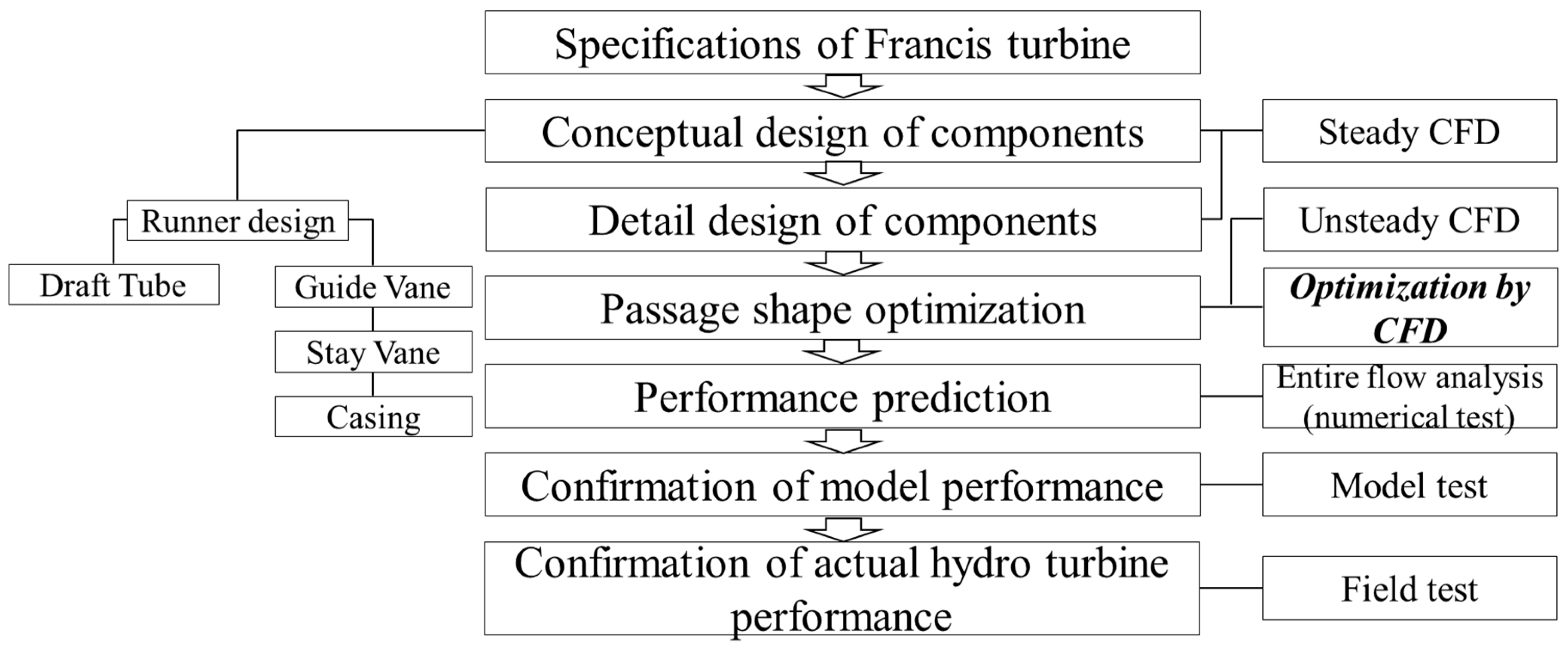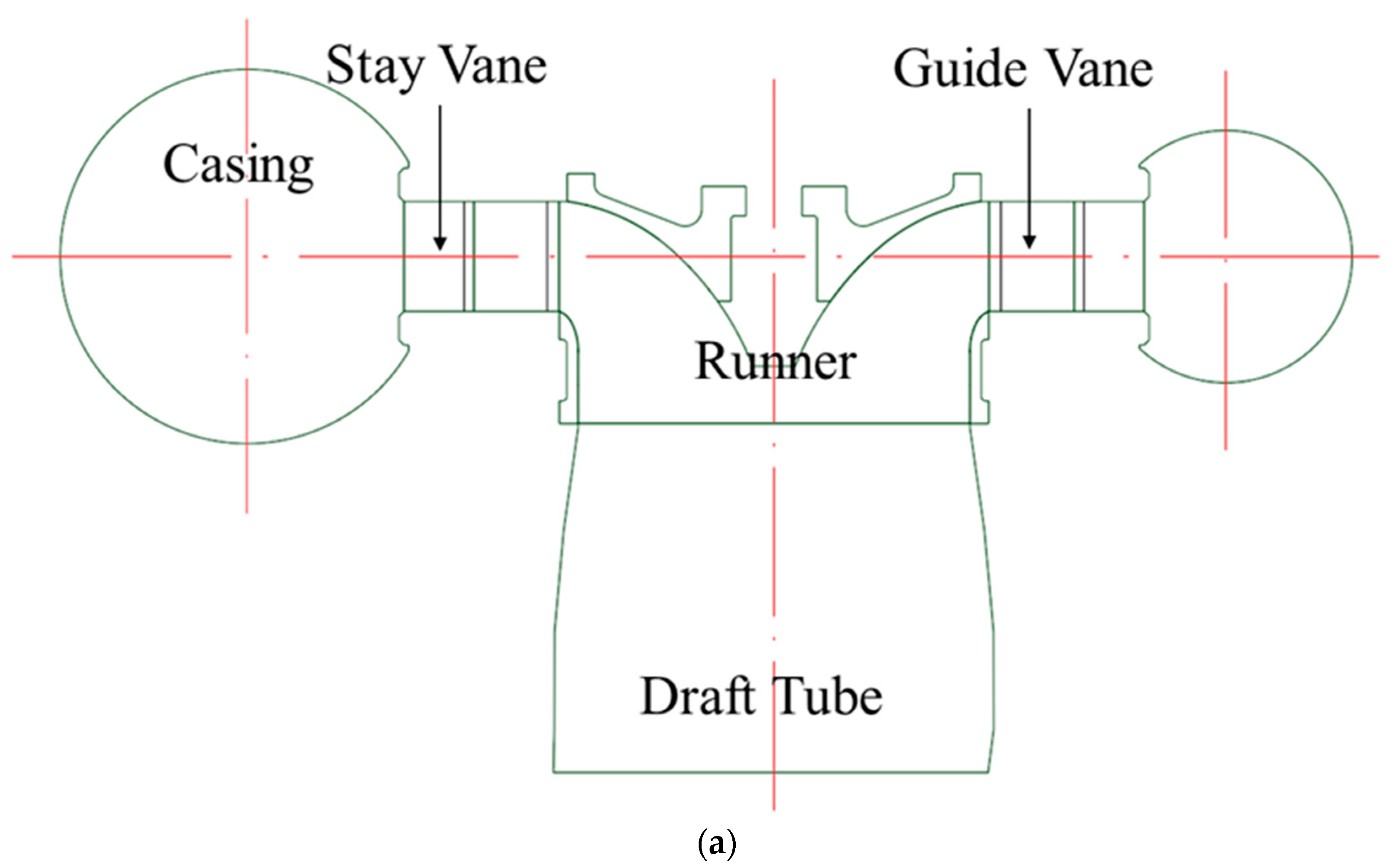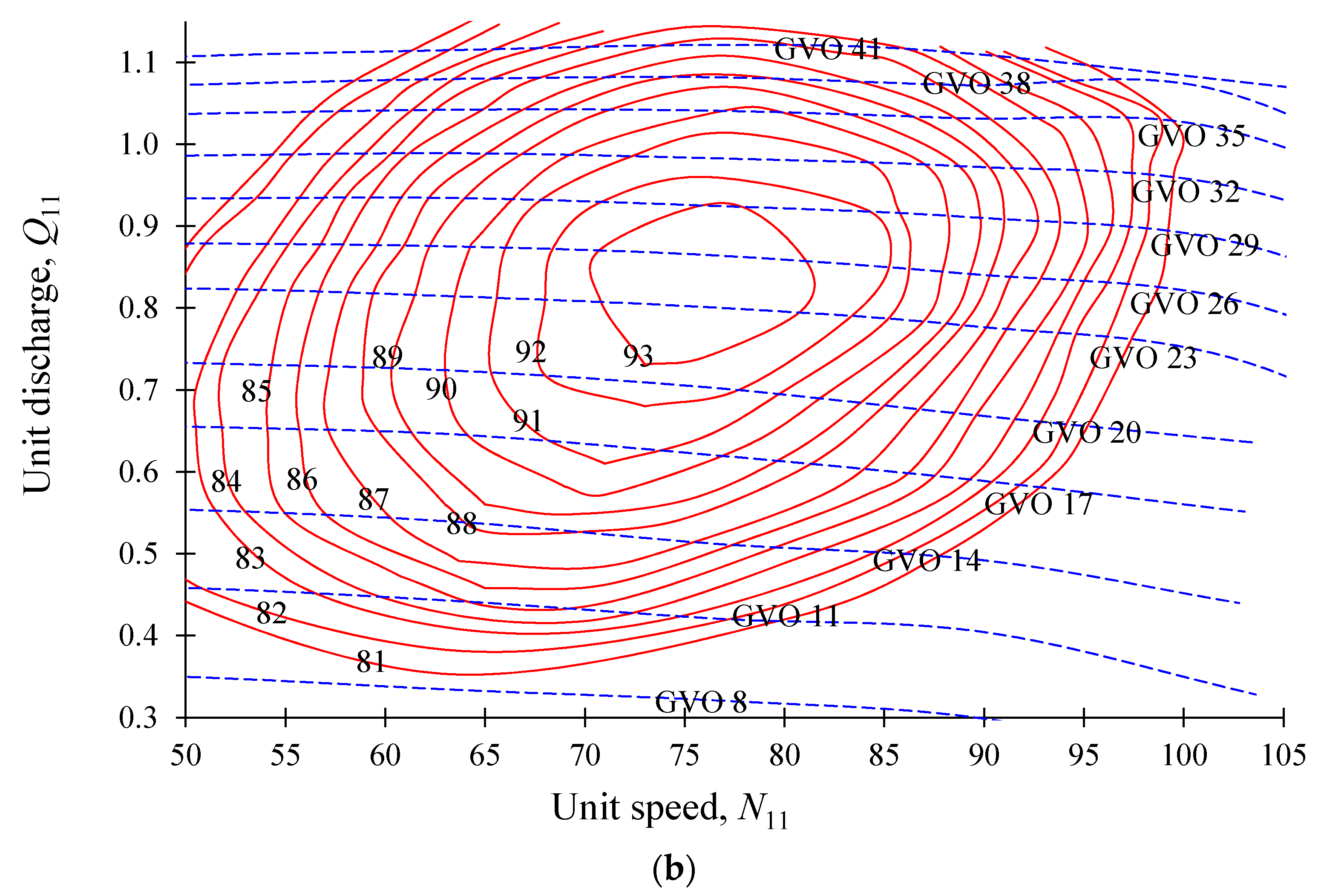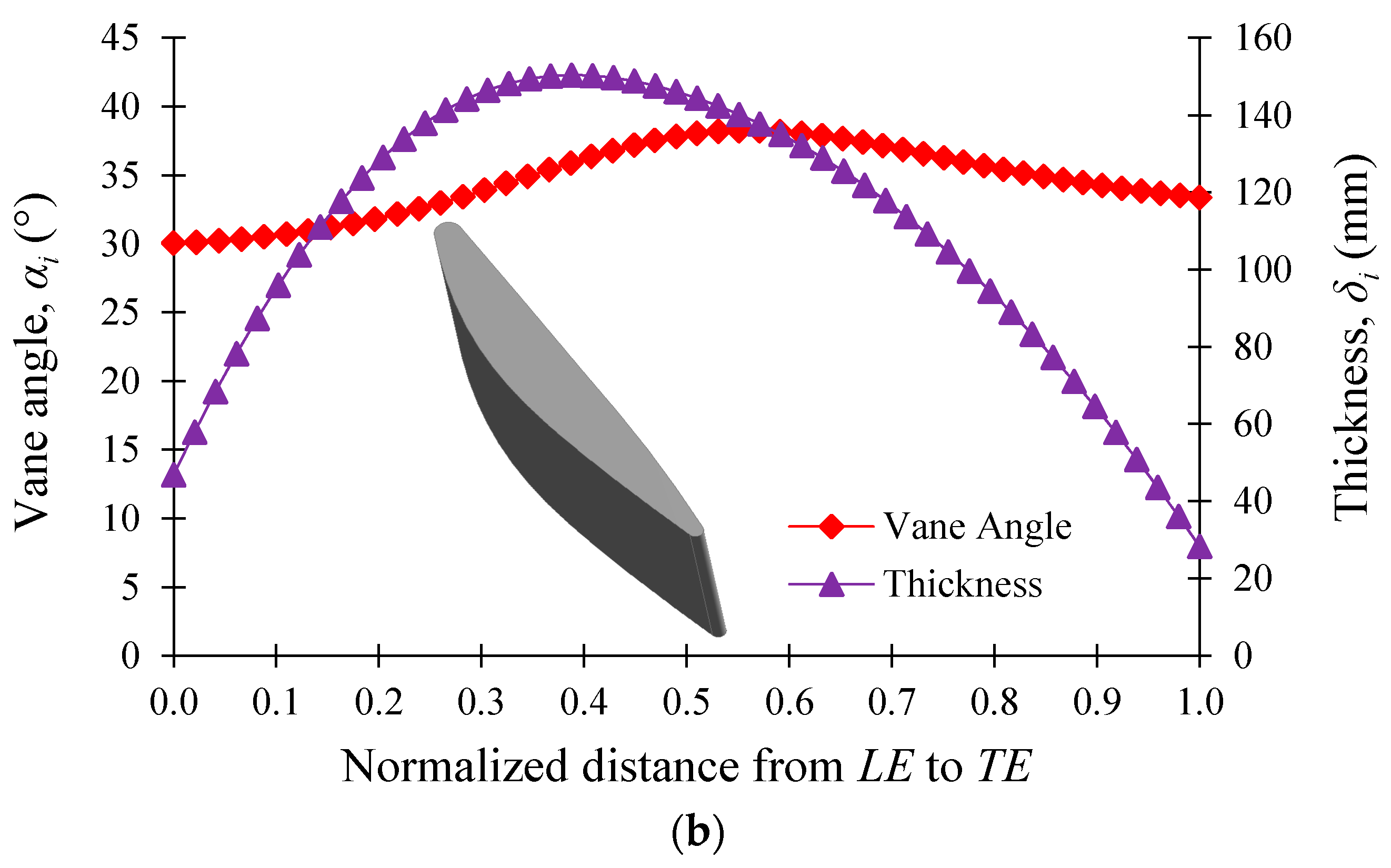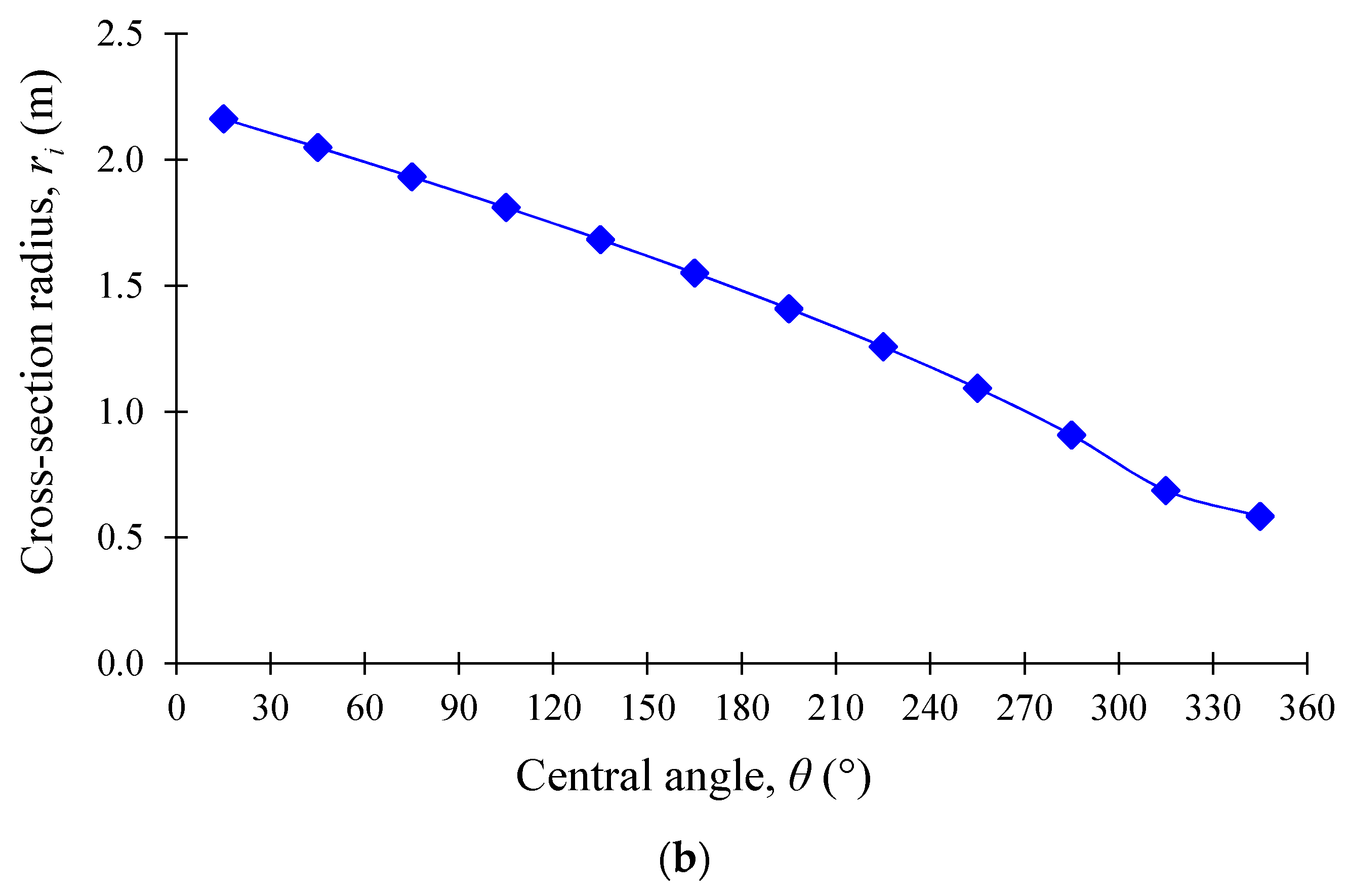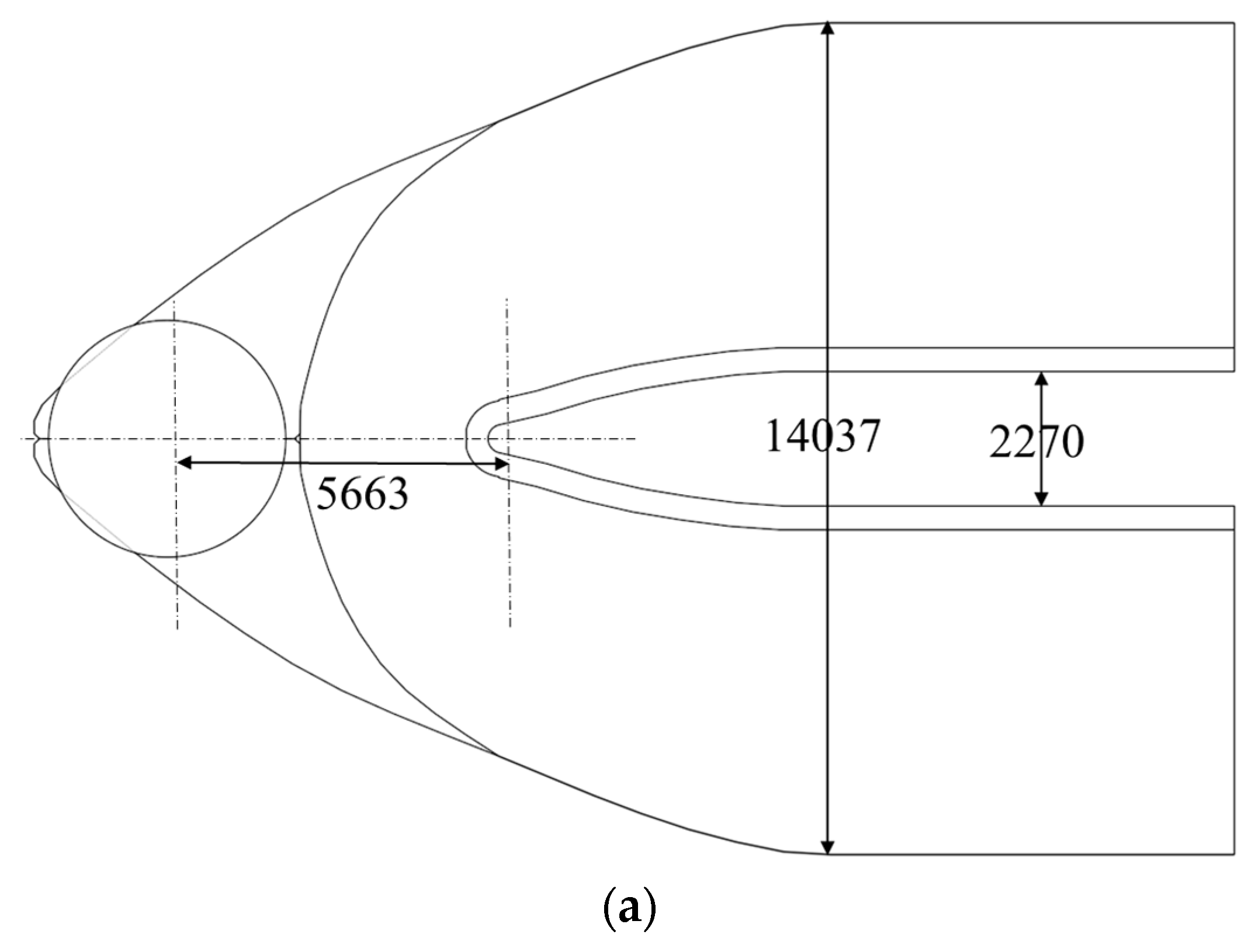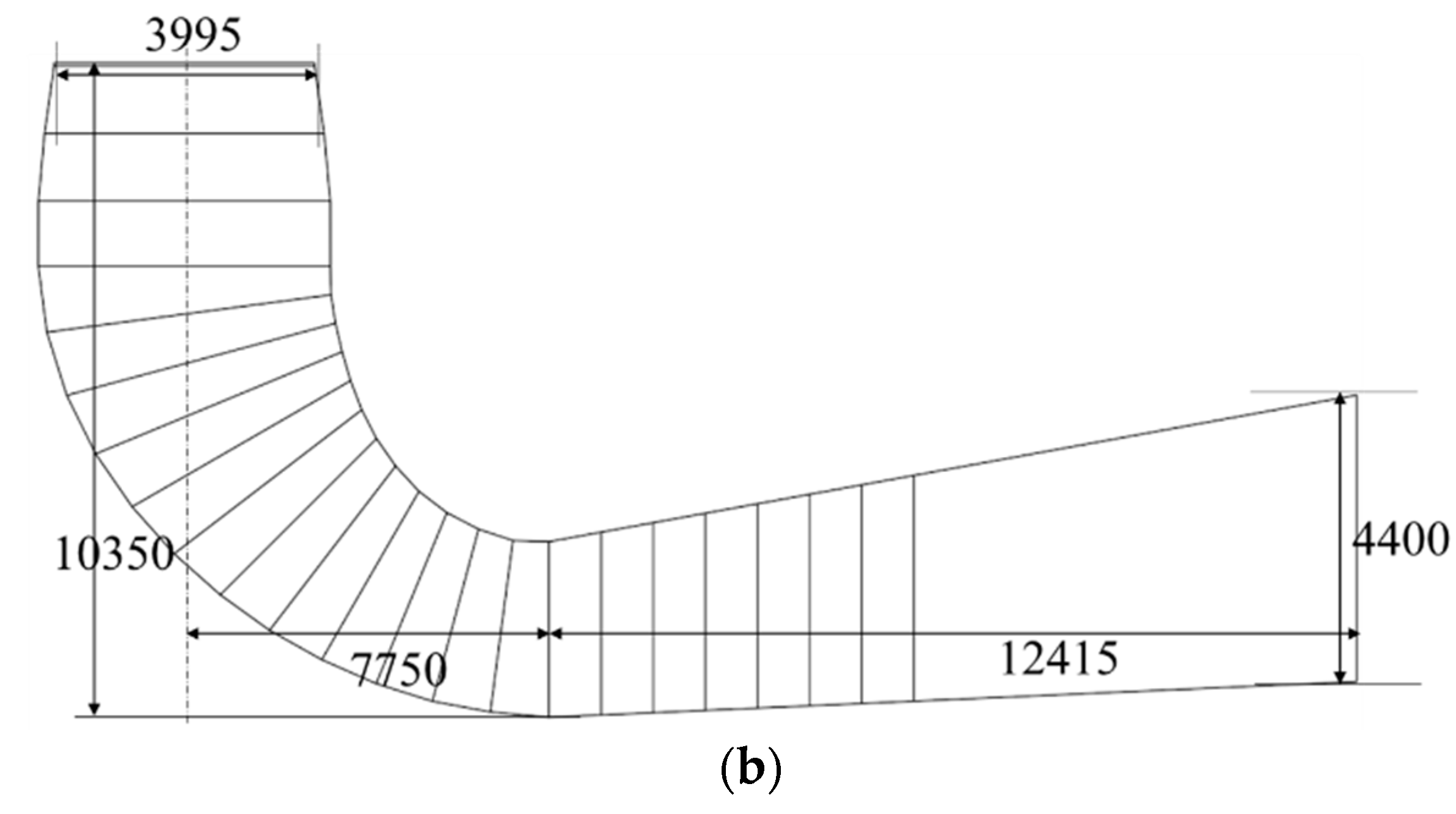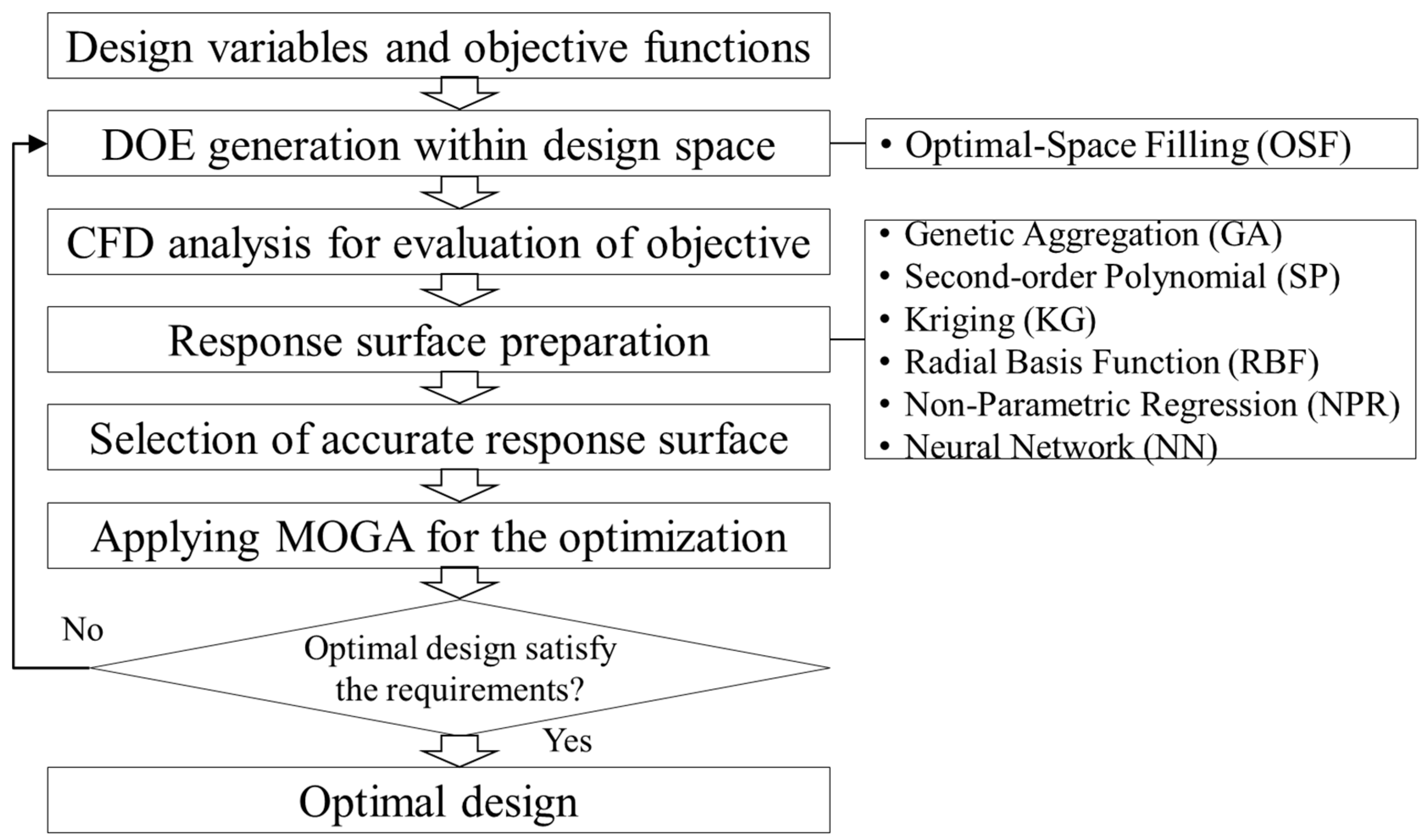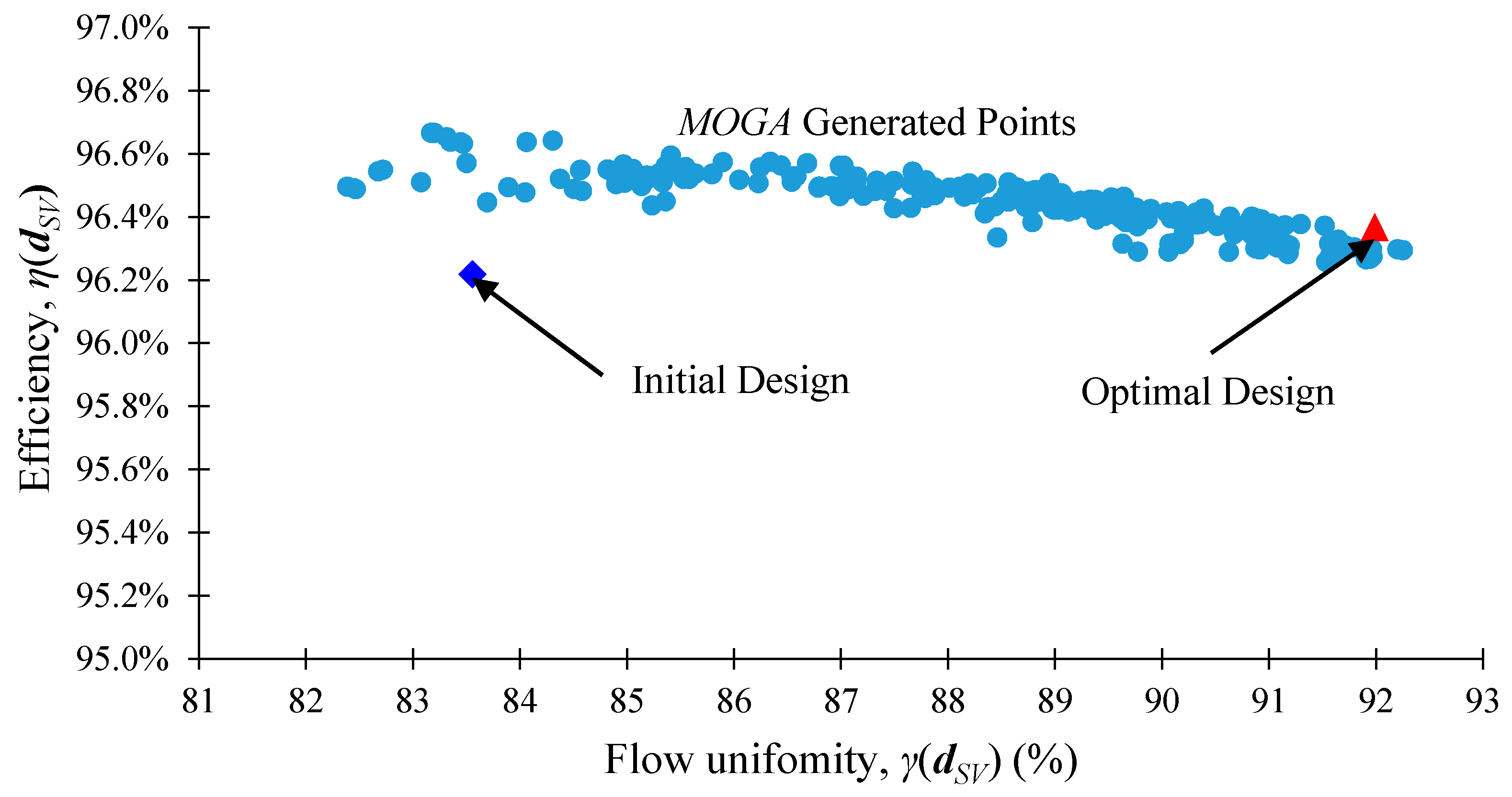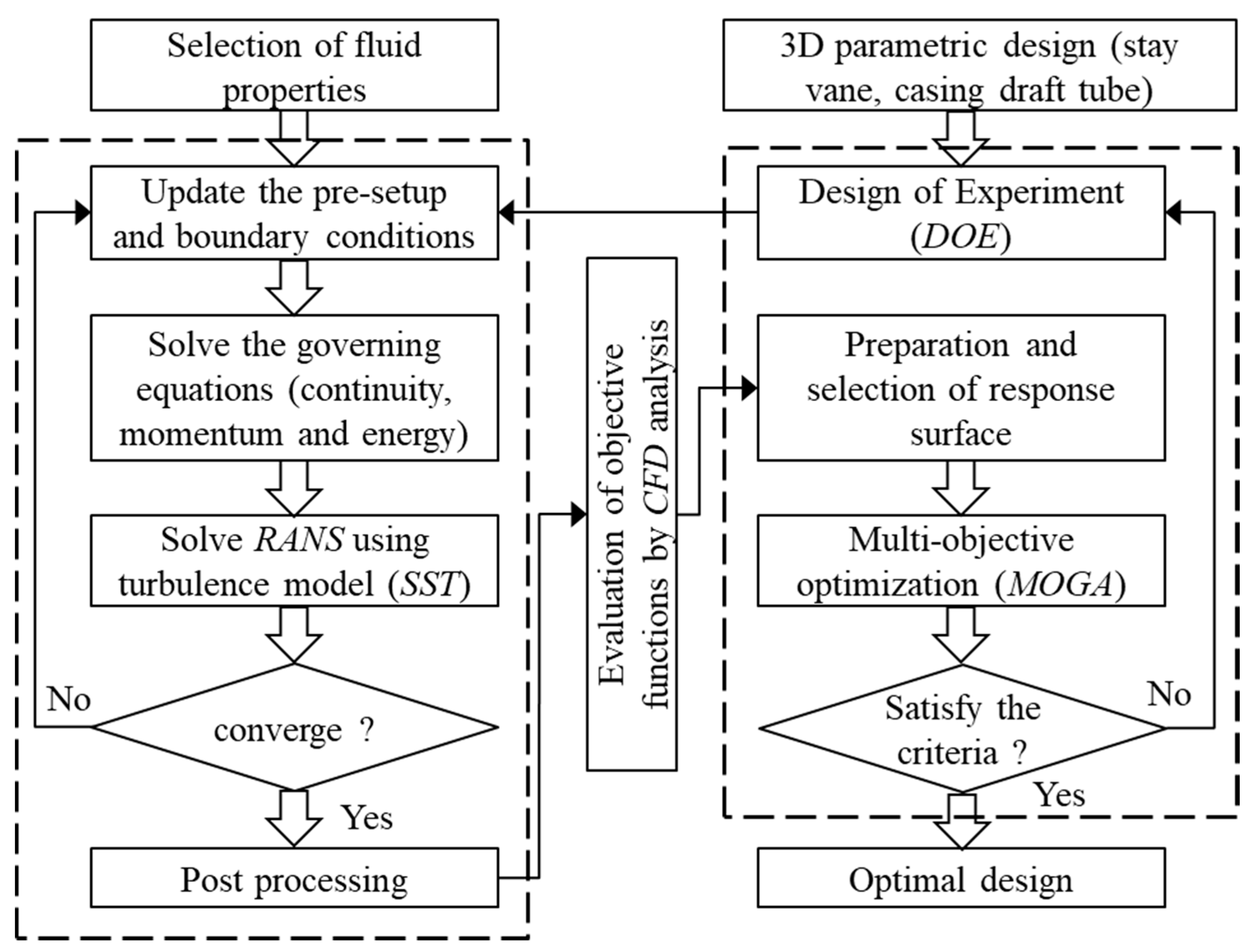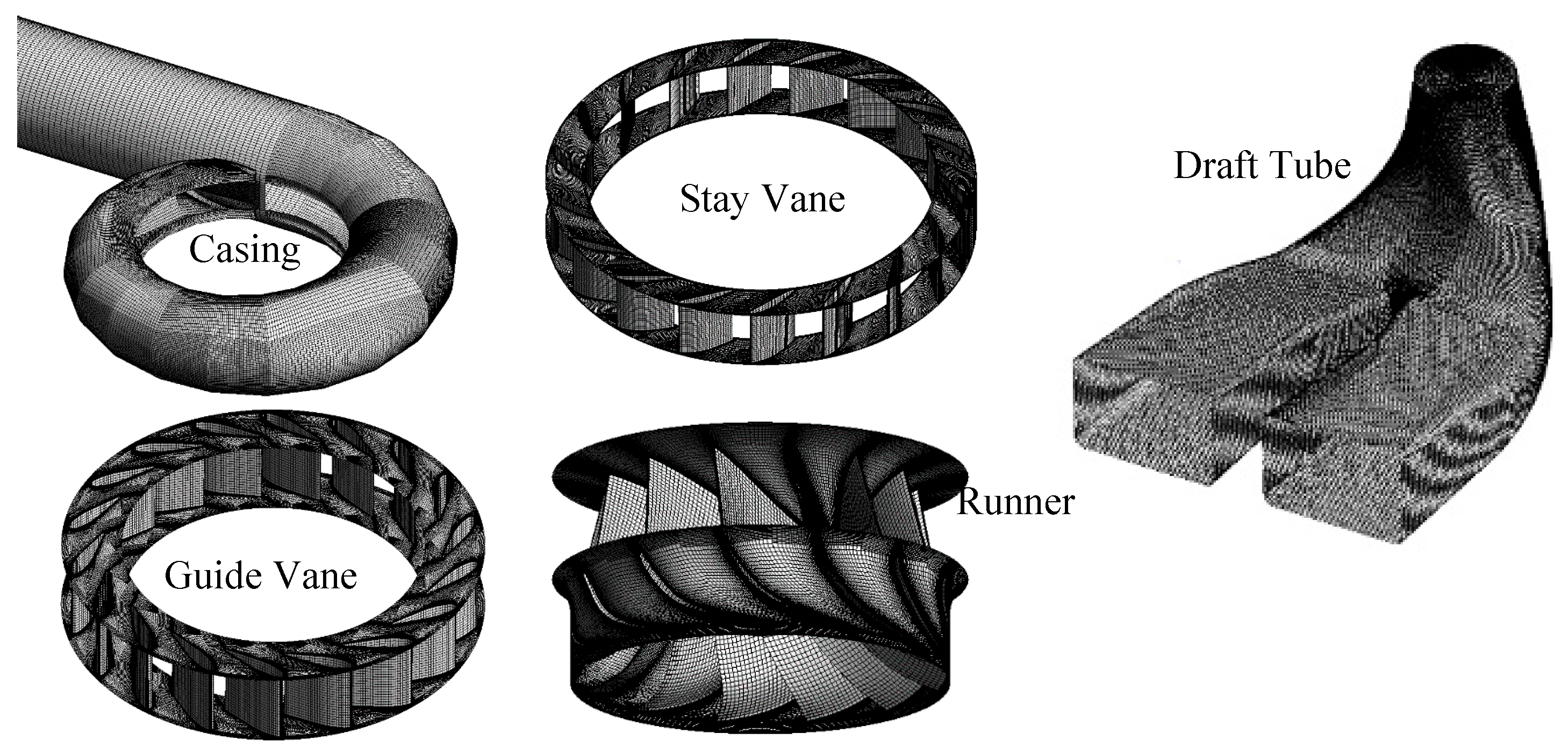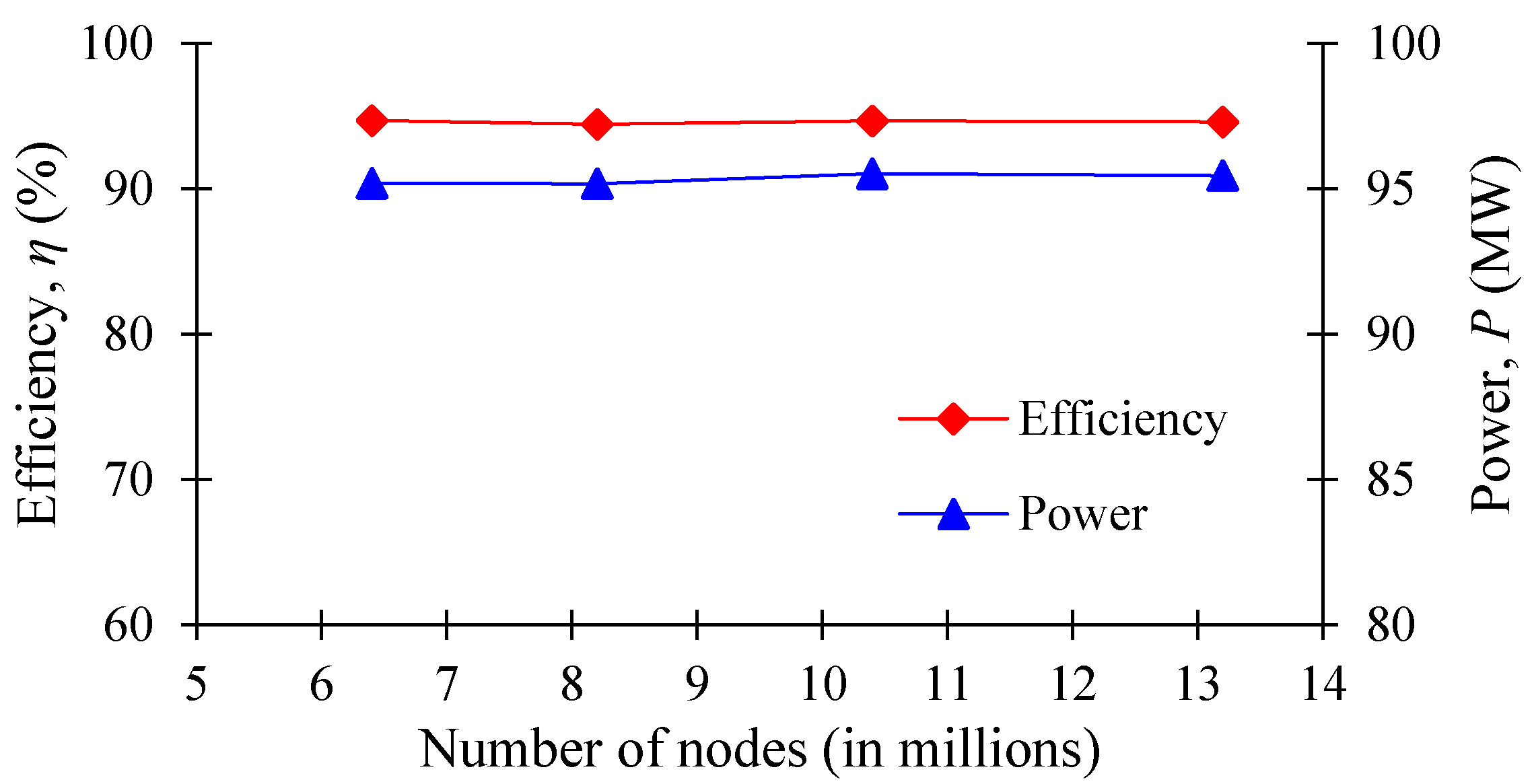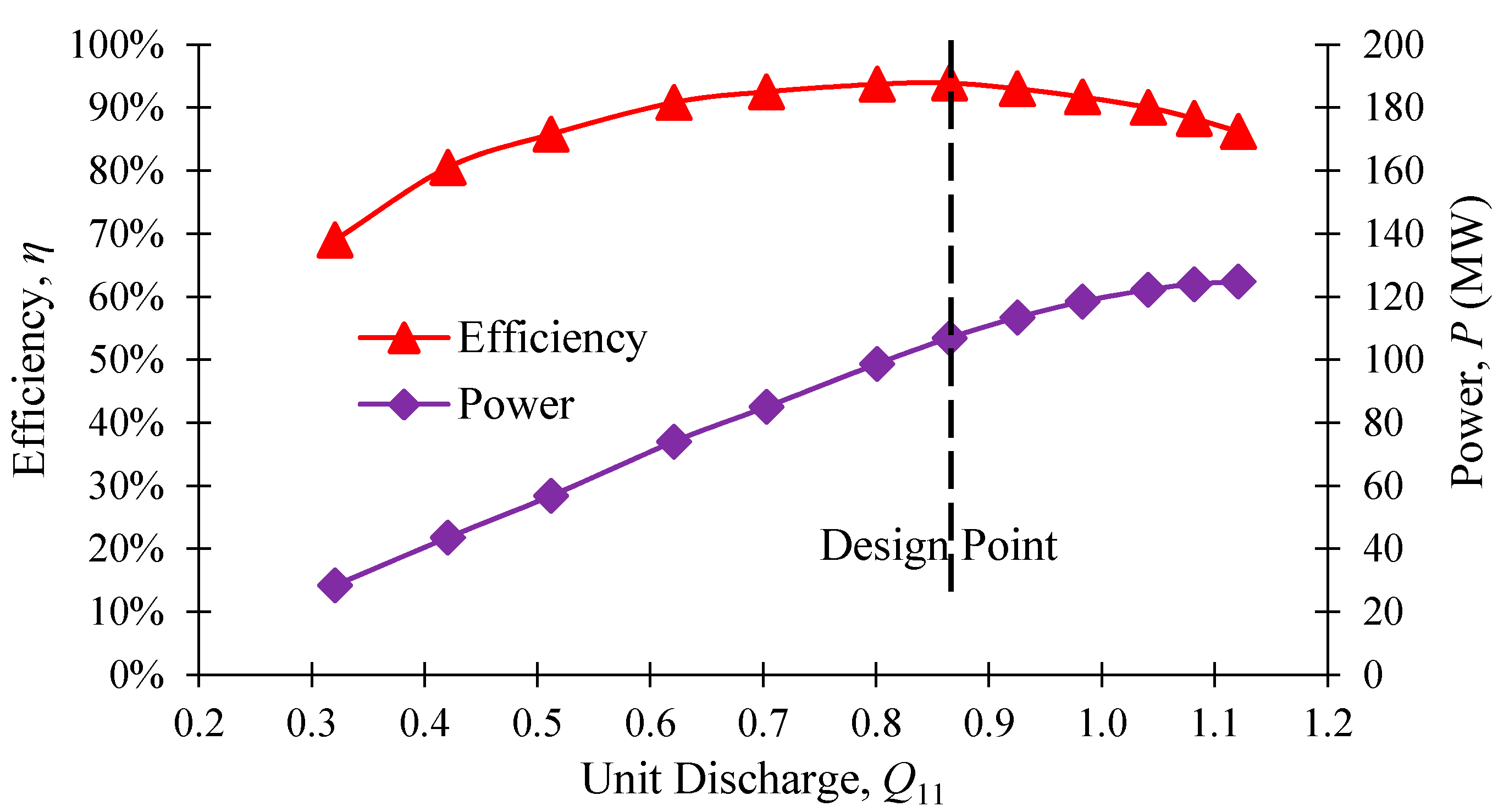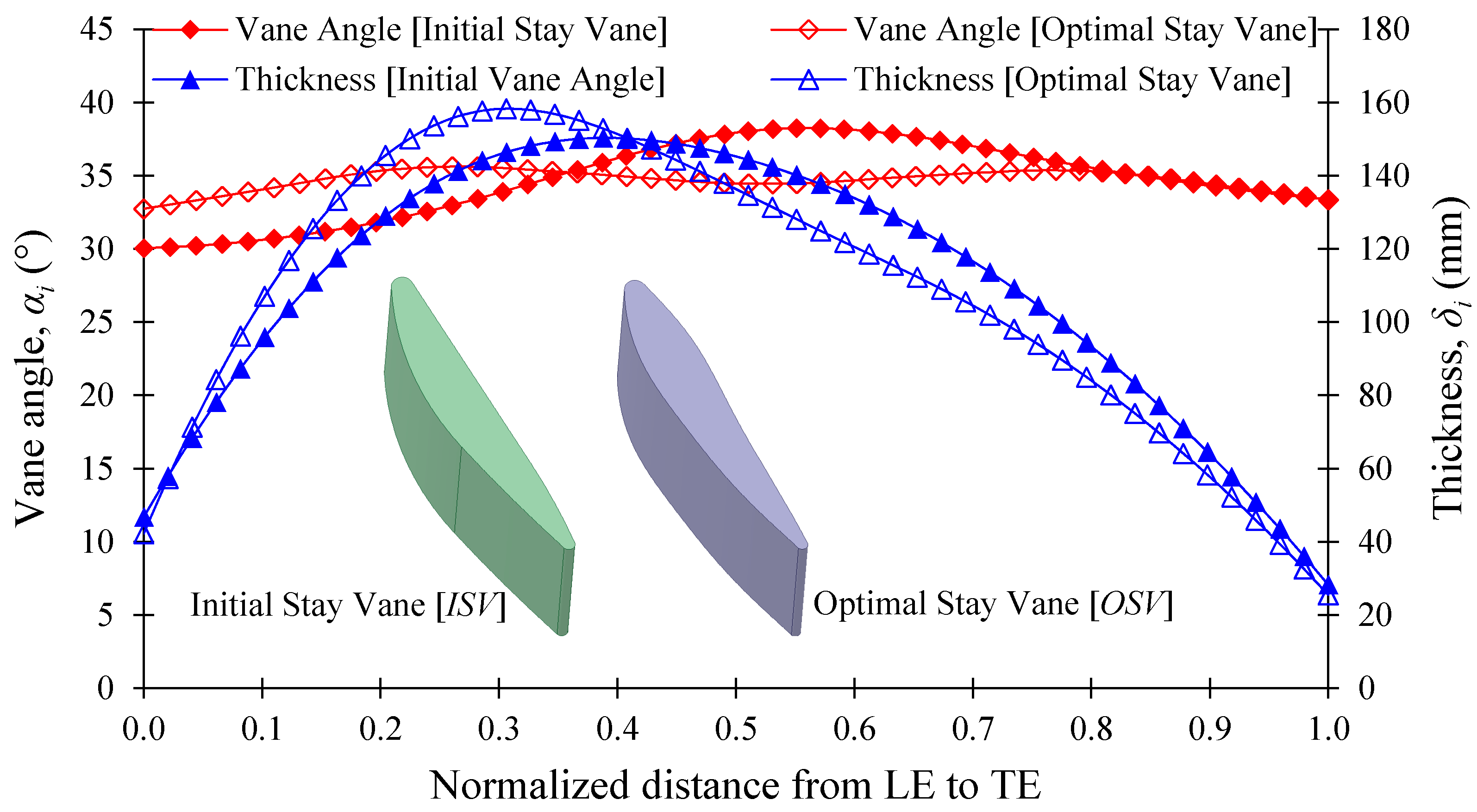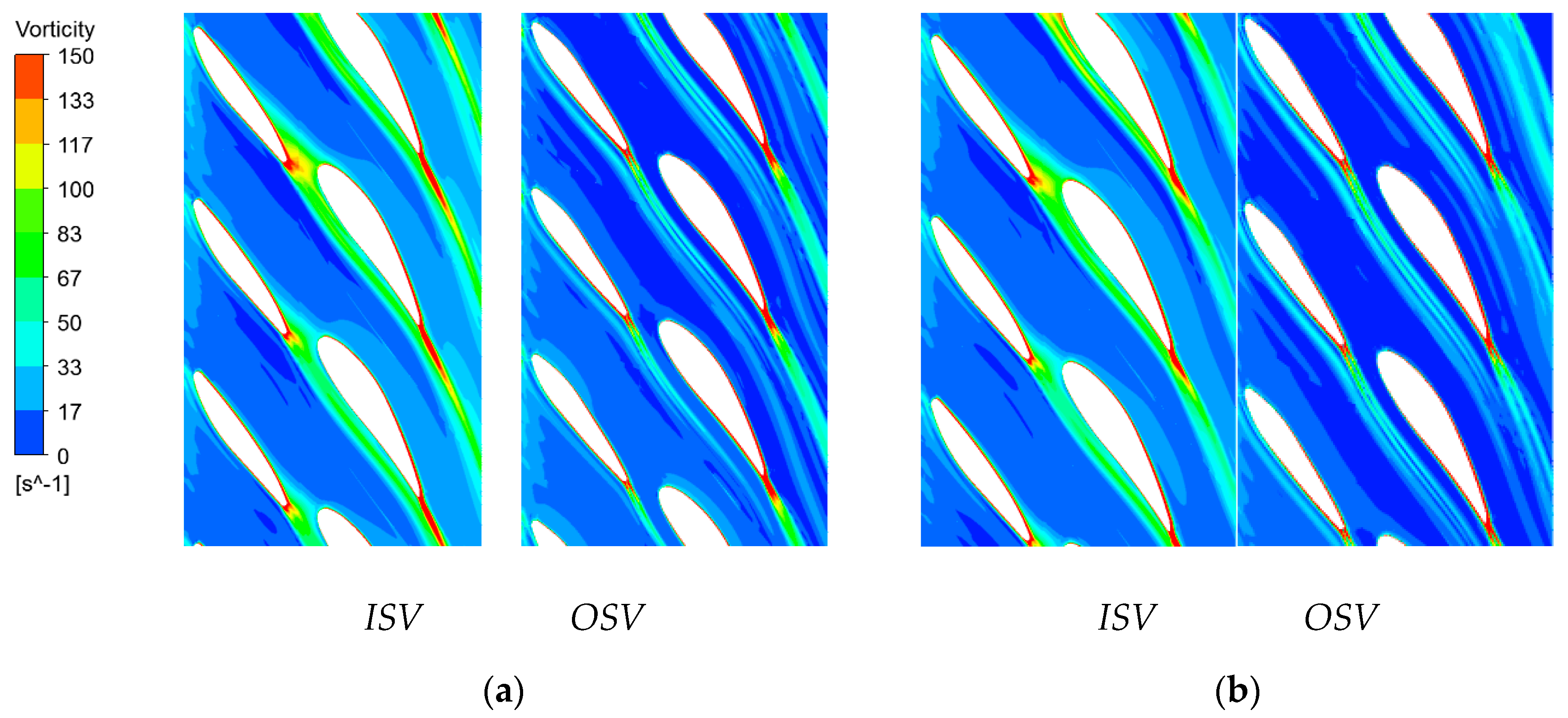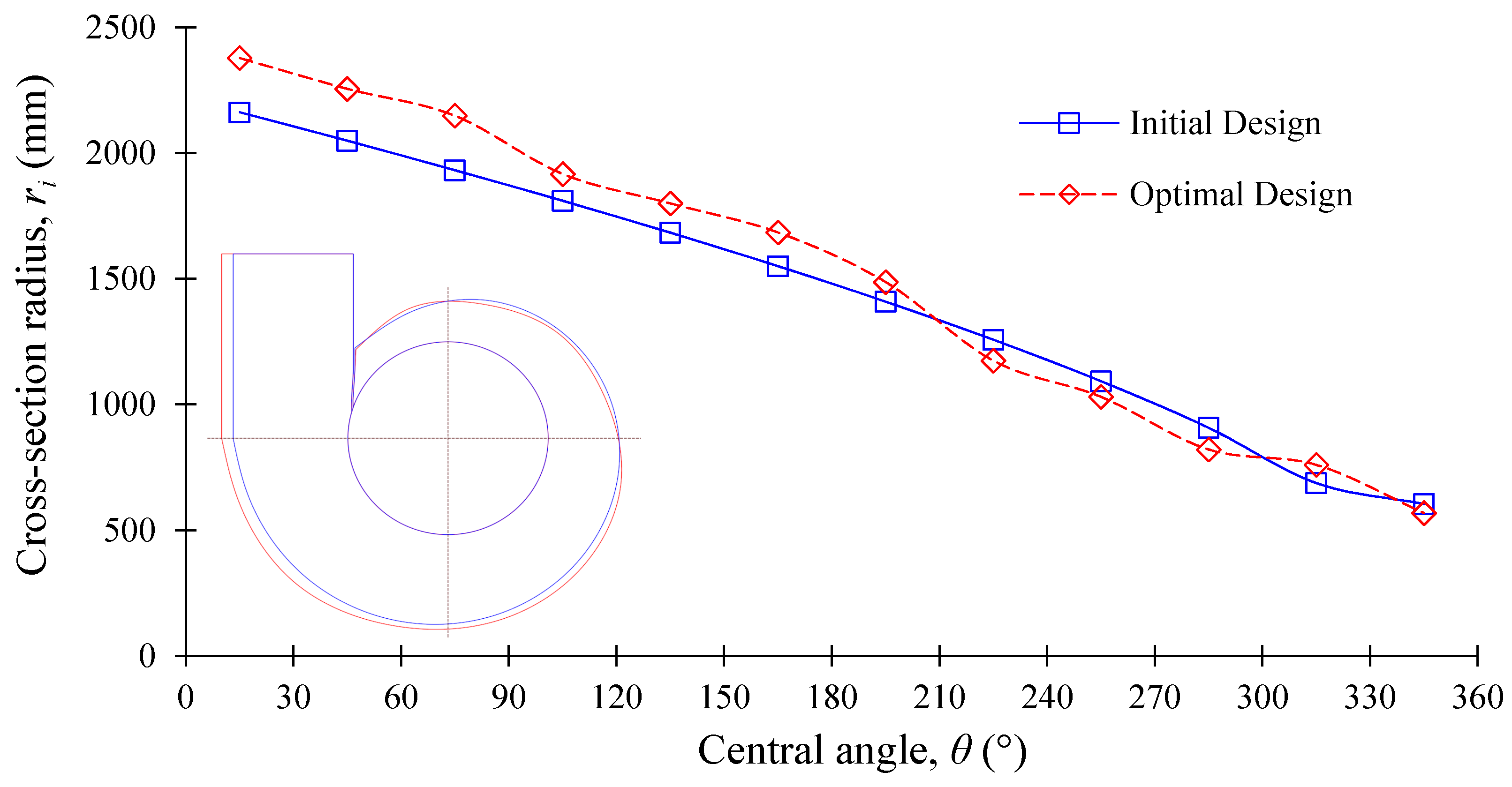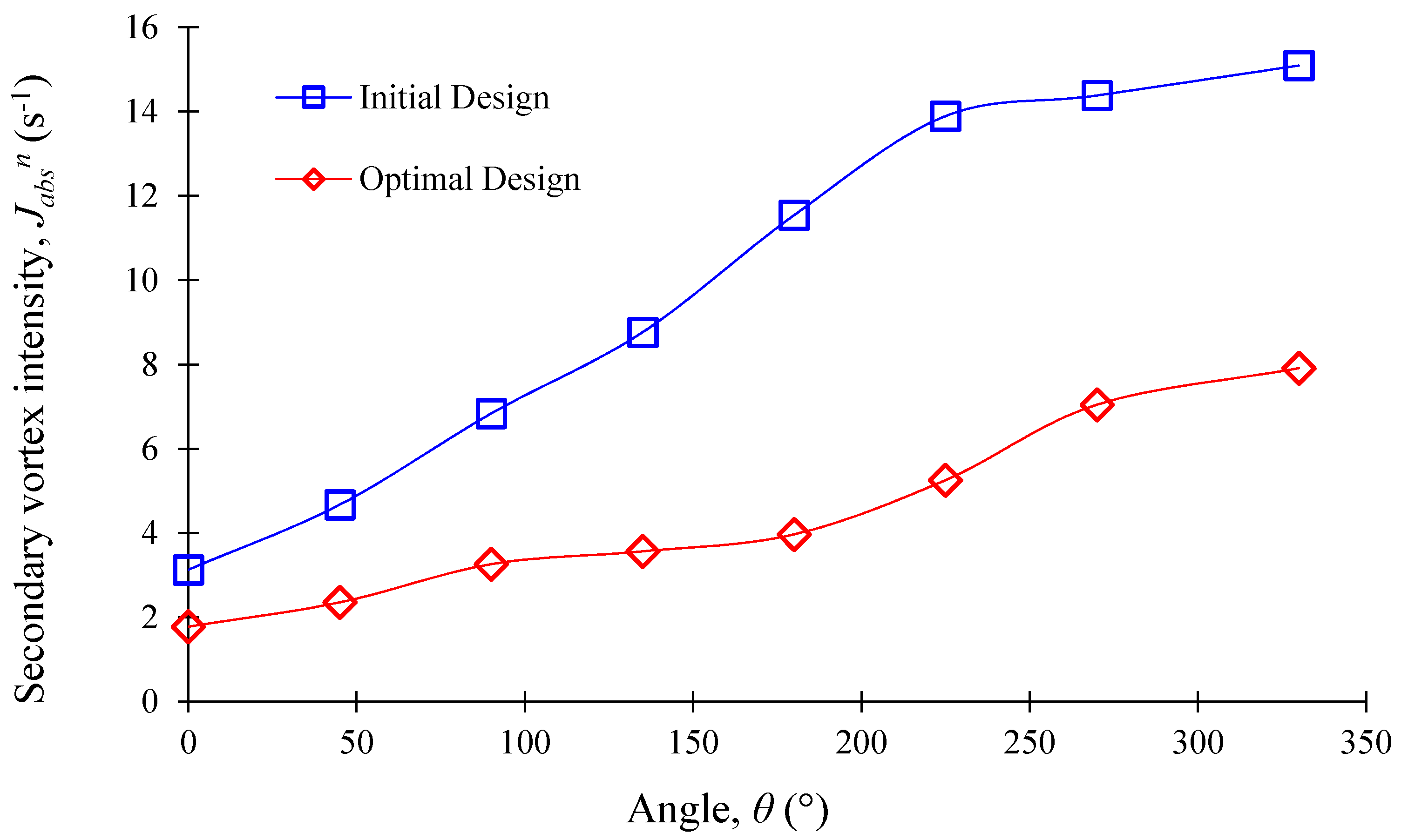Author Contributions
Conceptualization, U.S., and Y.-D.C.; methodology, U.S.; software, Y.-D.C.; validation, U.S. and Y.-D.C.; formal analysis, U.S.; investigation, U.S.; resources, Y.-D.C.; data curation, U.S.; writing—original draft preparation, U.S.; writing—review and editing, U.S. and Y.-D.C.; visualization, U.S.; supervision, Y.-D.C.; project administration, Y.-D.C.; funding acquisition, Y.-D.C. All authors have read and agreed to the published version of the manuscript.
Figure 1.
Hydraulic design process of the Francis hydro turbine with computational fluid dynamics (CFD)-based optimization.
Figure 1.
Hydraulic design process of the Francis hydro turbine with computational fluid dynamics (CFD)-based optimization.
Figure 2.
(a) Schematic view and (b) efficiency hill chart of the 100 MW class Francis hydro turbine by initial design.
Figure 2.
(a) Schematic view and (b) efficiency hill chart of the 100 MW class Francis hydro turbine by initial design.
Figure 3.
(a) Parametric design schematic view and (b) initial stay vane shape.
Figure 3.
(a) Parametric design schematic view and (b) initial stay vane shape.
Figure 4.
(a) Parametric design and (b) initial cross-section radius of casing (red line indicates measuring location).
Figure 4.
(a) Parametric design and (b) initial cross-section radius of casing (red line indicates measuring location).
Figure 5.
(a) Top view and (b) side view of draft tube (all dimensions are in mm).
Figure 5.
(a) Top view and (b) side view of draft tube (all dimensions are in mm).
Figure 6.
J-Groove shape install on the draft tube inner wall and design parameters.
Figure 6.
J-Groove shape install on the draft tube inner wall and design parameters.
Figure 7.
Optimization workflow for the 100 MW class Francis hydro turbine fixed flow passages. (DOE is Design of experiment and MOGA is Multi-Objective Genetic Algorithm).
Figure 7.
Optimization workflow for the 100 MW class Francis hydro turbine fixed flow passages. (DOE is Design of experiment and MOGA is Multi-Objective Genetic Algorithm).
Figure 8.
Pareto front for the optimization of stay vane design.
Figure 8.
Pareto front for the optimization of stay vane design.
Figure 9.
Pareto front for the optimization results of casing design.
Figure 9.
Pareto front for the optimization results of casing design.
Figure 10.
Pareto front for optimization of draft tube design at the design point.
Figure 10.
Pareto front for optimization of draft tube design at the design point.
Figure 11.
Numerical scheme of CFD analysis in combination with optimal design process (RANS is Reynolds-averaged Navier-Stokes).
Figure 11.
Numerical scheme of CFD analysis in combination with optimal design process (RANS is Reynolds-averaged Navier-Stokes).
Figure 12.
Numerical grids of the 100 MW class Francis turbine.
Figure 12.
Numerical grids of the 100 MW class Francis turbine.
Figure 13.
Mesh dependency test results for CFD analysis.
Figure 13.
Mesh dependency test results for CFD analysis.
Figure 14.
Validation of conceptual design of the 100 MW Francis hydro turbine by CFD analysis.
Figure 14.
Validation of conceptual design of the 100 MW Francis hydro turbine by CFD analysis.
Figure 15.
Comparison of initial and optimal stay vane designs for the 100 MW class Francis turbine.
Figure 15.
Comparison of initial and optimal stay vane designs for the 100 MW class Francis turbine.
Figure 16.
Comparison of flow angle in the ISV and OSV at the design point.
Figure 16.
Comparison of flow angle in the ISV and OSV at the design point.
Figure 17.
Comparison of vorticity in ISV and OSV flow passages (a) 0.25 span and (b) 0.75 span at design point.
Figure 17.
Comparison of vorticity in ISV and OSV flow passages (a) 0.25 span and (b) 0.75 span at design point.
Figure 18.
Comparison of initial and optimal casing design for the 100 MW class Francis turbine.
Figure 18.
Comparison of initial and optimal casing design for the 100 MW class Francis turbine.
Figure 19.
Comparison of secondary vortex intensity between initial and optimal casing designs.
Figure 19.
Comparison of secondary vortex intensity between initial and optimal casing designs.
Figure 20.
Comparison between (a) initial (b) optimal J-Groove models installed on the draft tube walls.
Figure 20.
Comparison between (a) initial (b) optimal J-Groove models installed on the draft tube walls.
Figure 21.
Comparison of swirl intensity in the draft tube by J-Groove shapes at the design point.
Figure 21.
Comparison of swirl intensity in the draft tube by J-Groove shapes at the design point.
Table 1.
Design specification of the 100 MW class Francis turbine.
Table 1.
Design specification of the 100 MW class Francis turbine.
| Nomenclature | Unit | Values |
|---|
| Effective head, H | m | 90 |
| Flow rate, Q | m3/s | 125.4 |
| Power, P | MW | 100 |
| Rotational speed, n | min−1 | 180 |
| Inlet diameter, Di | mm | 4863 |
| Outlet diameter, De | mm | 3995 |
| Specific speed, Ns | kW-min−1-m | 205 |
Table 2.
Results of goodness of fit test. (CoD is Coefficient of Determination, MRR is Maximum Relative Residual, RMSE is Root Mean Square Error).
Table 2.
Results of goodness of fit test. (CoD is Coefficient of Determination, MRR is Maximum Relative Residual, RMSE is Root Mean Square Error).
| Goodness Measure | RSM | Stay Vane | Casing | Draft Tube |
|---|
| | | | | | | |
|---|
| CoD | GA | 98% | 97% | 90% | 98% | 98% | 100% | 97% | 99% |
| SP | 98% | 96% | 89% | 100% | 99% | 77% | 95% | 77% |
| KG | 100% | 100% | 100% | 100% | 100% | 100% | 100% | 100% |
| RBF | 100% | 100% | 100% | 100% | 100% | 100% | 100% | 100% |
| NPR | 99% | 99% | 100% | 100% | 100% | 100% | 100% | 100% |
| NN | 99% | 98% | 92% | 88% | 89% | 28% | 77% | 34% |
| MRR | GA | 0.19% | 2.28% | 3.57% | 0.16% | 8.50% | 0.13% | 0.19% | 9.56% |
| SP | 0.10% | 3.04% | 35.74% | 0.13% | 31.20% | 0.11% | 0.69% | 16.65% |
| KG | 0.09% | 1.86% | 42.96% | 0.42% | 20.06% | 0.23% | 2.94% | 18.08% |
| RBF | 0.09% | 0.09% | 57.45% | 0.10% | 17.83% | 0.13% | 0.94% | 14.05% |
| NPR | 0.19% | 1.97% | 38.10% | 0.52% | 9.78% | 0.08% | 0.88% | 10.11% |
| NN | 0.15% | 1.47% | 28.3% | 0.54% | 20.13% | 0.05% | 0.65% | 6.17% |
| RMSE | GA | 0.01% | 0.51% | 0.02% | 0.03% | 1.46% | 0.01% | 0.02% | 0.01% |
| SP | 0.01% | 1.36% | 0.04% | 0.13% | 31.20% | 0.01% | 0.06% | 0.02% |
| KG | 0.01% | 0.89% | 0.05% | 0.42% | 20.06% | 0.06% | 0.09% | 0.07% |
| RBF | 0.01% | 0.06% | 0.04% | 0.10% | 17.83% | 0.01% | 0.06% | 0.01% |
| NPR | 0.02% | 1.37% | 0.04% | 0.38% | 7.54% | 0.01% | 0.06% | 0.01% |
| NN | 0.01% | 0.82% | 0.03% | 0.35% | 16.51% | 0.03% | 0.04% | 0.01% |
Table 3.
Information of setting criteria for MOGA.
Table 3.
Information of setting criteria for MOGA.
| Parameter | Value |
|---|
| Number of initial samples | 300 |
| Maximum number of cycles | 30 |
| Number of samples per cycle | 100 |
| Crossover probability | 0.95 |
| Mutation probability | 0.05 |
| Maximum allowable Pareto percentage | 97 |
| Convergence stability percentage | 2 |
Table 4.
Bounds for design variables of stay vane.
Table 4.
Bounds for design variables of stay vane.
| Design Variable | | |
|---|
| α1 | 26° | 32° |
| α2 | 29° | 36° |
| α3 | 34° | 42° |
| α4 | 32° | 39° |
| α5 | 30° | 36° |
| δ1 | 40 mm | 52 mm |
| δ2 | 120 mm | 155 mm |
| δ3 | 135 mm | 155 mm |
| δ4 | 95 mm | 120 mm |
| δ5 | 25 mm | 35 mm |
| ale, ate | 0.7 | 1.25 |
Table 5.
Bounds for design variables of casing.
Table 5.
Bounds for design variables of casing.
| Design Variable | | |
|---|
| r0 | 1900 mm | 2400 mm |
| r1 | 1800 mm | 2300 mm |
| r2 | 1700 mm | 2200 mm |
| r3 | 1600 mm | 2000 mm |
| r4 | 1500 mm | 1900 mm |
| r5 | 1350 mm | 1750 mm |
| r6 | 1250 mm | 1600 mm |
| r7 | 1100 mm | 1400 mm |
| r8 | 950 mm | 1250 mm |
| r9 | 800 mm | 1000 mm |
| r10 | 600 mm | 800 mm |
| r11 | 500 mm | 700 mm |
Table 6.
Bounds for design variables of draft tube shape.
Table 6.
Bounds for design variables of draft tube shape.
| Design Variable | | |
|---|
| dJG | 50 mm | 200 mm |
| θJG | 8° | 20° |
| lJG | 1500 mm | 3000 mm |
| 9 | 21 |
Table 7.
Numerical grids information.
Table 7.
Numerical grids information.
| Components | Node Number | Mesh Size (mm) | Y + Value |
|---|
| Casing | 435,922 | 7.5 | 29.5 |
| Stay Vane | 1,561,220 | 2.5 | 22.9 |
| Guide Vane | 2,520,000 | 3.0 | 34.3 |
| Runner | 2,294,595 | 5.0 | 84.2 |
| Draft Tube | 1,428,835 | 9.0 | 14.4 |
| Total | 8,240,572 | | |
Table 8.
Summary of boundary conditions for CFD analysis.
Table 8.
Summary of boundary conditions for CFD analysis.
| Parameter/Boundary | Condition/Value |
|---|
| Inlet | Total Pressure |
| Outlet | Static Pressure |
| Rotational speed | 180 min−1 |
| Turbulence model | Shear Stress Transport (SST) |
| Grid interface connection | General Grid Interface (GGI) |
| Physical time scale | Steady State/0.0531 s |
| Time step | Unsteady State/0.00185 s (2° per time step for 1 revolutions) |
| Interface model | Steady State/Frozen rotor Unsteady State/Transient rotor stator |
| Walls | No slip wall (roughness: smooth) |
Table 9.
Results of stay vane optimization for the 100 MW class Francis turbine.
Table 9.
Results of stay vane optimization for the 100 MW class Francis turbine.
| Parameter | Initial Stay Vane (ISV) | Optimal Stay Vane (OSV) |
|---|
| Head (m) | 89.23 | 89.23 |
| Flow Rate (m3/s) | 130.36 | 130.64 |
| Power (MW) | 106.95 | 107.23 |
| Efficiency (%) | 93.91 | 93.96 |
| Flow Uniformity (%) | 91.73 | 95.04 |
| Head Loss (m) | 0.438 | 0.403 |
Table 10.
Results of casing optimization for the 100 MW class Francis turbine.
Table 10.
Results of casing optimization for the 100 MW class Francis turbine.
| Parameter | Initial Design | Optimal Design |
|---|
| Flow Uniformity (%) | 97.46 | 97.51 |
| Head Loss (m) | 0.256 | 0.145 |
Table 11.
Comparison of design parameter size of J-Grooves for draft tube shape optimization.
Table 11.
Comparison of design parameter size of J-Grooves for draft tube shape optimization.
| Design Parameter of J-Groove | Initial Size | Optimal Size |
|---|
| Length, lJG (mm) | 2000 | 2455.5 |
| Depth, dJG (mm) | 106 | 169 |
| Angle, θJG (°) | 12 | 8.7 |
| Number, | 15 | 21 |
Table 12.
Summary of draft tube shape optimization results for the 100 MW class Francis turbine.
Table 12.
Summary of draft tube shape optimization results for the 100 MW class Francis turbine.
| Parameters | Without J-Groove | Initial J-Groove | Optimal J-Groove |
|---|
| Head (m) | 88.41 | 88.40 | 88.42 |
| Flow Rate (m3/s) | 125.4 | 125.53 | 125.50 |
| Power (MW) | 102.16 | 101.79 | 102.1 |
| Efficiency (%) | 94.12 | 94.09 | 94.08 |
| Swirl Intensity Reduction (%) at z/R0 = 2.25 | | 12.12 | 18.79 |
